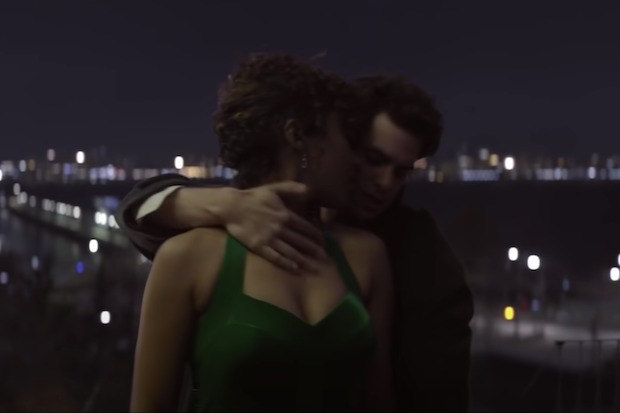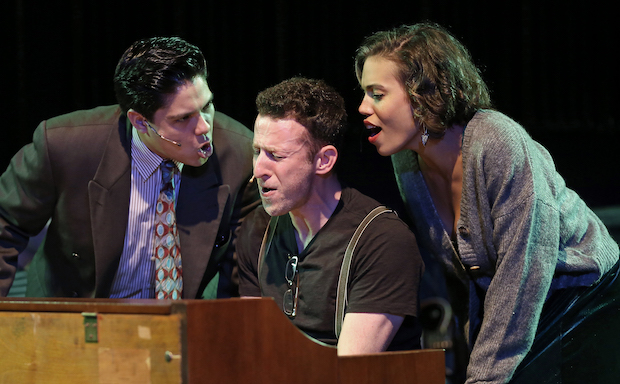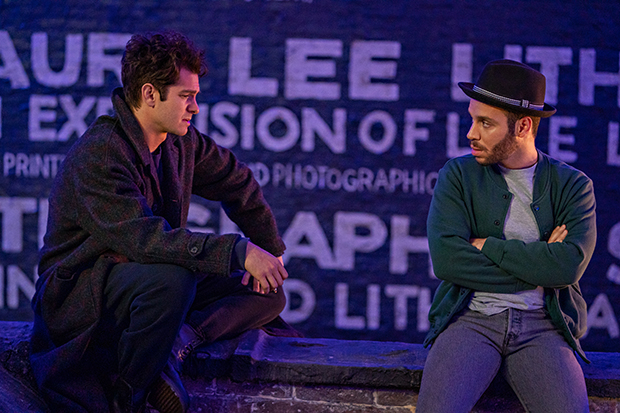Shedding "Green Green Dress": How Lin-Manuel Miranda Redefined Tick, Tick…Boom!
Why did Miranda cut an iconic song from his film adaptation of Jonathan Larson’s musical?

(© Netflix)
On March 17, Netflix released footage of a cut sequence from Tick, Tick…Boom! — the choreography-heavy "Green Green Dress" as performed by Andrew Garfield and Alexandra Shipp and directed by Hamilton creator Lin-Manuel Miranda. Almost immediately, social media lit up with fans confused by its removal from the final film. Many hoped that it would be reinstated in a director's cut. It is easy to understand that instinct. In any other movie musical, a buoyant number between the romantic leads would be expected, if not required. Tick, Tick…Boom!, however, is not any other movie musical.
Originally a semi-autobiographical solo show, Tick, Tick…Boom! was heavily revised following the death of its creator, Jonathan Larson. It was revamped as a three-actor piece 2001, and it is this three-hander version that became standard, receiving numerous productions, tours, and revivals in the intervening decades. Much of the music became embedded in the theatrical community, with "Come to Your Senses," "Green Green Dress," and "Louder Than Words" becoming standout tracks. When it was first announced that "Green Green Dress" had been excised from the song list of the Tick, Tick…Boom! film adaptation, many were confused. Why would Miranda cut one of the show's iconic songs?

(© Carol Rosegg)
The answer is deceptively simple. When pressed to explain the decision, Miranda has always kept it brief: "It wasn't serving the story." The sequence, while incredibly entertaining, paused the action of the plot for several minutes, and unlike the song "Boho Days," which would have preceded the sequence in the film, "Green Green Dress" did not introduce us to any characters or relationships with which the audience was not already familiar. We know that Jonathan and Susan are together, that their relationship has a push-pull tension to it, and that Susan is holding something back. In the stage show, this rehash of their dynamic is not an issue; as a three-hander, there aren't many characters to meet in the first place, and many musicals have a song that exists primarily on the basis of entertainment.
If Tick, Tick…Boom! had been a traditional stage-to-screen adaptation, "Green Green Dress" would have likely been retained, justified by the conventions that supported it in the musical. However, Tick, Tick…Boom! is not a traditional stage to screen adaptation. In fact, it can be argued that it is one of the cinema's very few prominent biopic musicals (Yankee Doodle Dandy being another).
In the musical theater, there are two types of songs: diegetic and non-diegetic. Diegetic means that the characters are fully aware that they are singing, as in "The Point of No Return" in The Phantom of the Opera. Non-diegetic means that the characters are not aware that they are singing, as in "If I Loved You" from Carousel. When non-diegetic songs are utilized within a musical, it requires a certain suspension of disbelief for the action to move forward. The acceptance of non-diegetic music is one of the primary conventions of musical theatre.

(© Macall Polay/Netflix)
With biopics, however, viewers have an expectation that what they're watching is at least a facsimile of the truth. This expectation of accuracy poses a problem when biographic film is combined with musical theater, a genre that exists in a different reality of emotional expression.
Miranda achieved this tonal compromise by excising "Green Green Dress." The song, which is non-diegetic, is one of the most theatrical sequences of the stage show; nearly every other song is diegetic, with Jon presenting his work concert style. Still, within the film, two non-diegetic songs are preserved: "Swimming," which presents Jon's stream of creative consciousness in voiceover, and "No More," a raucous number between Jon and his best friend, Michael.
So, why keep "No More" and cut "Green Green Dress"? Both focus on one of the two primary relationships in Jon's life, both possess infectious melodies, and both explore Jon's inability to hear what is being communicated to him by the other party. The difference is that one is an expression of affection between two individuals who speak the same language, and the other is an expression of desire between two individuals who are decidedly not on the same wavelength.
Susan and Jon cannot speak the same language. That divide is the source of their rift throughout the narrative; they aren't on the same page about anything, including their artistry. Jon is a composer who is consumed by his music, unable to fully divorce his focus from it for even a moment. Susan is a dancer who longs for the stability a more conventional life would afford her. If "Green Green Dress" had been retained in the final edit, Susan would have been forced into a U-turn from being in total sync with Jon, to being on the outer edges of his orbit, in order to move the plot forward with her acceptance of a job in the Berkshires. Omitting the song makes it clear that she had been building up to this discussion all night. Susan cannot sing: that fundamental difference is the chasm that separates them. In fact, Susan does not sing in the film until "Come to Your Senses," which is actually not Susan the character; it is Jonathan composing what he wishes Susan had said to him. Susan herself has exited, unable to exist in Jon's world.
This single decision, to excise "Green Green Dress," seismically shifted the tone of Tick, Tick…Boom!, turning it from a movie musical adaptation that held to the conventions of its stage counterpart, to a biopic musical that was as eager to engage with the conventions of film as it was with theater. It did not apologize for either genre, instead embracing its status as a new kind of movie musical; one with as much emphasis on the former genre as it has on the latter. As we move forward into the 21st century, one can only hope that other directors will heed Miranda's shrewd sense of storytelling; so long as the songs serve the story, you will remain on solid ground.








